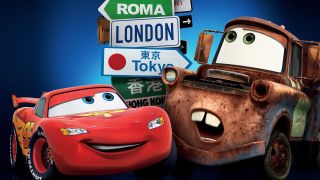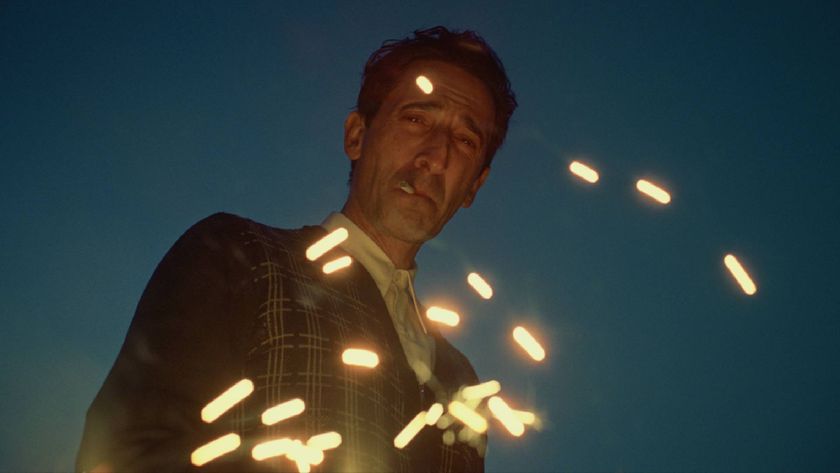Hear me out but… Pixar’s Cars is definitely set in a post-human, apocalyptic hellscape

Pixar’s Cars might be the studio’s most financially successful series (when you take the planet-crushing merchandise sales into account), but it’s also a searing goddamn nightmare of a thing. Year in, year out, kids flock innocently toward the gurning visages of Lightning McQueen toys, but there’s a secret darkness lurking beneath this heady carnival of cartoon consumerism.
It’s not even that secret, to be honest. More a hiding-in-plain-sight faceslap of transparently disguised horror, much like a lurking Predator perched shimmering and murderous in a jungle tree. Wordlessly, the Cars movies state their dread truth through every aspect of their grim countenance. Because, friends, the Cars movies play out in a post-apocalyptic hellhole future, in which flesh and bone have fallen to steel and glass, and every vein runs toxic and stinking with petrol, oil, and brake fluid.

The internet, of course, has known this for a long time. Theories as to the exact nature of this soulless landscape of roaring mechanical dread are various and diverging, but all agree upon its existence. Because let’s think about the Cars set-up for a moment. Its world is clearly Earth. We know this from the various Earth-based place names on roadsigns and in plot references, and from the appearance of Earth maps. But Cars’ world is populated only by vehicles, with not a human in sight. Nevertheless, this world was clearly built for humans, and therefore, logically, by humans.
There are buildings, with human-sized doors, rooms, and staircases – which cars, with their broad frames and heavy wheels, cannot use. There are towns and cities, with pavements. Pavements traditionally exist separate to roads, created specifically for use by those with legs. The London Eye ferris wheel exists. So does the Eiffel Tower. These landmarks could not have been built by cars, tractors, or planes, nor would such sentient machinery have any use for such things. Motor vehicles persist with their notorious lack of appendages, with not an opposable thumb in sight. And heck, what are the tractors even farming when no-one around eats food? The world of the cars in Cars is not their world, and yet they possess it. Our descendants are living machinery, their metal-plated bodies painted with a clown-faced parody of our own species’ identity.
A wide web of horrors

Now this week’s Hear Me Out is going to differ slightly from previous ones. In most of these articles I pick out a single fan theory (or come up with a brand new one), and then explore it to its natural conclusion in an attempt to create the deepest, most watertight version possible. But with the sinister removal of humanity from Cars’ Earth so utterly unquestionable, I’m instead going to take a look at the various available versions of the theorised back-story for this horrific status quo, and try to pick a favourite. Because not only are there a whole heap of variously repugnant expository treatments floating around, but a few of them tap into even bigger ideas. Ideas that I’d need a dedicated series to do proper justice to. There is a lot to talk about here.
The most basic version, of course, is that the humans are dead. That’s the easiest way to rationalise all of this away, but it does leave us with a few extra questions which, if answered keenly, can help us pinpoint more exactly what went down. For starters, why is everyone dead? In most movies, the answer would be ‘they nuked each other, the dumb monkeys’, but that’s not the case here. Because, wear and tear aside, the world in Cars looks pretty undestroyed. It doesn’t feel like this was a violent mass-extinction. A viral outbreak is more likely. Something that could wipe out an entire species in pretty short order, while causing minimal immediate collateral damage.
That established, how far into the future is Cars set? Well the first clue to that matter comes with the cars themselves. Because having established that Cars plays out on our Earth, rather than some cartoon parallel universe where humans somehow never happened (but their vehicles did), technological advancement is the most immediately plausible explanation for this fuel-injected uber-race.
Sign up for the Total Film Newsletter
Bringing all the latest movie news, features, and reviews to your inbox

Because with self-driving cars now an actual reality, the path to fully-AI vehicles is already paved. There’s a clear developmental line between Tesla Autopilot and a thinking, feeling, talking species of autonomous automobiles, albeit a line with a rather unpredictable length. So while the route is plausible, we’re probably looking at quite a long stretch of time before we reach that destination. As fast as tech development tends to work, the evolution of true AI has been relatively slow. It’s a tricky timeline to pin down.
So let’s also talk about corpses. Because the sudden death of the entire human race would leave a heck of a lot of them lying about, stinking up the place something rotten. Yet there are none in Cars. Nary a background spine. It’s unlikely Cars’ vehicles would have been able to clear up and presumably bury/cremate an entire planet’s worth of bodies, so taking human decomposition rates into account, we can estimate a little more accurately.
It takes up to a year for an exposed, unburied corpse to be reduced to the state of a skeleton, which on its own isn’t entirely useful for dating Cars. But the bones themselves can then take between another decade and several millennia to decompose, depending on the environmental conditions. And thus we have a (sort of) answer. We’re not talking about a Terminator-style, near future apocalypse here. It’s more likely something akin to The Matrix, Destiny, or even Planet of the Apes.
A place of many deaths

Not that a viral death is the only explanation for mankind’s fall. Pollution could have done it, unbreathable air or an entirely shattered ozone layer combining with global warming to make the planet uninhabitable to humans. And if so, that would add several thick lashings of deliciously dark irony to the Earth’s subsequent takeover by exhaust-belching automatons. Or if we’re willing to look a little further left-field, some kind of supernatural apocalypse could even be the cause. I’m perhaps being influenced by having written about Ghostbusters recently, but we can’t rule this one out.
And if supernatural forces and/or far future technology were involved, it’s also not impossible that the cars of Cars might actually be the missing humans. It would be a delightful paranormal punishment for humanity to be turned into sentient vehicles in recompense for wrecking the planet with fossil fuels, just as our species’ desperation download of its collective consciousness into hardy metal motor vehicles in order to survive the planet’s new conditions would be an ironic twist worthy of The Twilight Zone. Hey, if Altered Carbon can stick human consciousness into a snake, I’m saying human hybrid AI tow-trucks are totally legit. And of course, there’s the even grimmer, outright body-horror version of this theory.
And naturally, I cannot ignore the bigger-picture theories here. Because frankly, if you well enough fit the personality Venn diagram required to have got this far (aka. ‘Pixar fan with pioneering delight in fanciful, slightly paranoid bullshit’, in which case, welcome, for you are truly my people), then you’re probably already thinking of connective narrative opportunities in the studio’s other movies. Wall-E, of course, explicitly features an Earth abandoned by humans in the face of an environmental apocalypse, upon which AI now roam. Cars could logically be a continuation of that story, but set centuries later, after the attempted human reclamation of the planet has failed and the robots have converted themselves into faster, more carefree, and entirely more fun forms after finally giving up on helping the bumbling flesh pods.
A universe of dread

And beyond that, I must - with a sharp intake of breath and a pre-emptive tear of almighty mental effort already upon my eye - finally move on to the Unified Pixar Universe Theory. Because dear God, the Unified Pixar Universe Theory. While certainly not watertight, Jon Negroni’s proposed single timeline for all Pixar movies is a masterpiece of connective speculation, running from prehistory to the far future, and linking every film by way of time-travel, magic, and an alternative evolutionary path instigated by the extended survival of the dinosaurs.
I’ll let you dig into it properly yourself, but suffice to say that its timeline’s later periods absolutely take in a post-human Earth dominated by AI cars, with strong causal links to the Wall-E era. Shortly afterward, the ants take over, a few centuries before the planet is handed over to monsters. Maybe clear an afternoon before clicking that link.
Got a favourite theory yet? There are plenty here that I like, but there’s one further pondering of even greater darkness that I’m particularly partial to: the theory that, although absent from the Cars movies, humanity is not, in fact, entirely dead. Although it doubtless wishes that it was. You may or may not remember a 1986 horror movie called Maximum Overdrive, written and directed by Stephen King. Maximum Overdrive tells a tale of vehicles come to sinister life, under the influence of a passing comet. They attack and bully humankind throughout the film, but toward its conclusion their motivations shift toward subjugation, as they realise that they remain partly reliant on the squishy bipeds for their maintenance.

A late scene features a bulldozer and a motorised machine gun turret joining forces in order to ‘persuade’ some human survivors to refill a truck’s fuel tank. And here we have another inception point for the world of Cars. And one with a fair degree of logic to it. Perhaps, having risen to intelligence, and witnessed their creators’ increasing inability to manage their own shit, let alone maintain a planet they can safely live on, the intelligent cars – having realised that Earth is becoming increasingly suited to themselves rather than humanity – have taken action. They’ve pushed the remaining humans ‘safely’ under the surface, to act as a slave society of mechanics and maintenance workers, tending to their machine overlords’ basic needs, but never again to enjoy autonomy over a planet they have unwittingly given away.
Forget the furnace scene in Toy Story 3. Forget the heartbreaking opening of Up. Cars. Goddamn Cars. That’s where Pixar gets really dark.
Oh, and did I mention that a lot of this is basically canon?
Hear Me Out is GR's regular exploration, extrapolation, and expansion on the biggest and best movie fan theories and alternative takes around. From whole new interpretations, to critical angles you hadn't thought of, it's your home for the weirder side of film. Looking for more? Check out last week’s case for why Alien: Resurrection is secretly brilliant if it's all Ripley's dying fever dream at the end of Alien 3.
Most Popular






